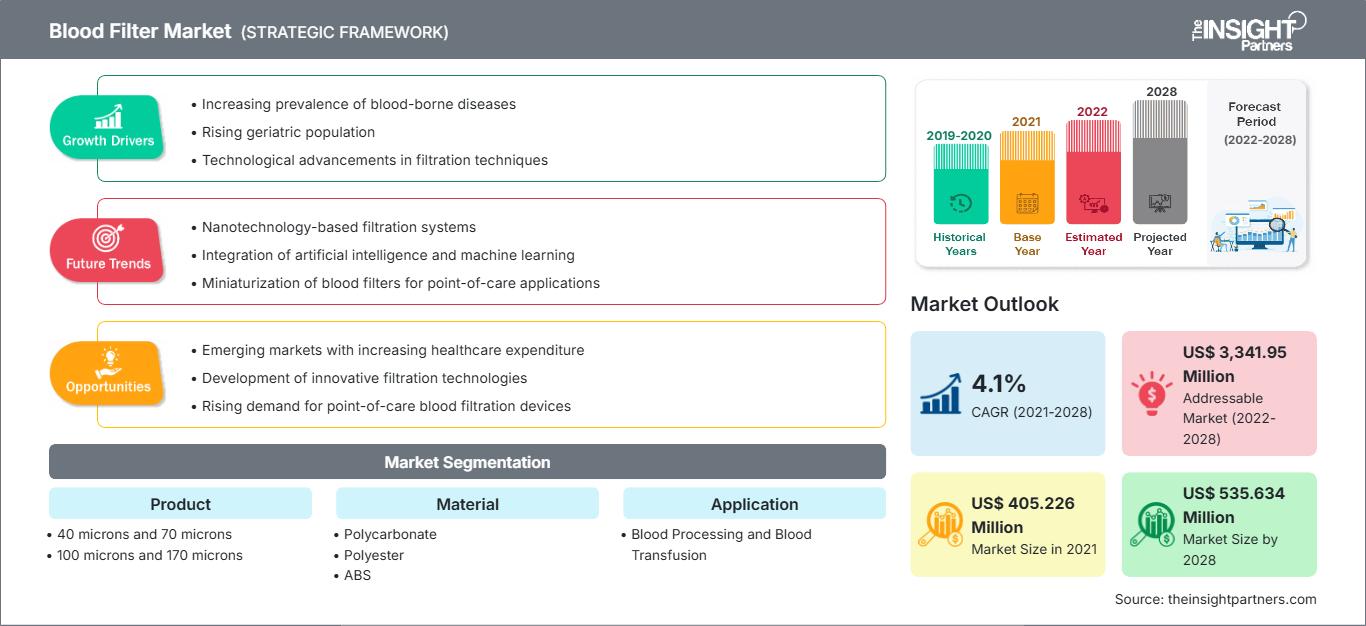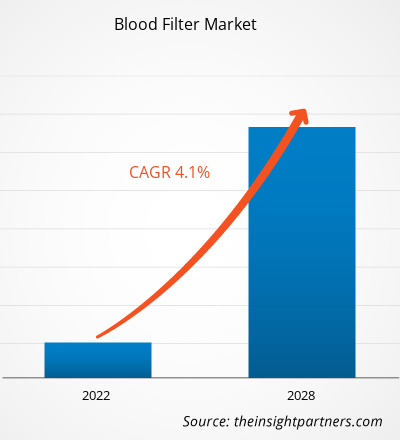血液フィルター市場は、2021年の4億522万6000米ドルから2028年には5億3563万4000米ドルに達すると予測されており、2021年から2028年にかけて4.1%のCAGRで成長すると推定されています。
血液フィルターは、ポリエステルまたはナイロン製の織りメッシュで構成されたスクリーンタイプのフィルターで、製品バッグと患者の間に配置され、濾過を行います。これらのフィルターは、血流に入ると危険なマクロ凝集体や非血液成分の微粒子物質から患者を保護することを目的としています。輸血中に、ミクロ凝集部位やフィブリン凝集体などのマクロ凝集体を除去します。濾過には、血液保存中に形成された白血球、フィブリン、血小板からなる粒子やマクロ凝集体を捕捉することが含まれます。慢性疾患の負担増加、外傷や事故の急増、輸血件数の増加といった要因が、血液フィルター市場の成長を牽引しています。しかしながら、製品リコールが市場の成長を阻害しています。
要件に合わせてレポートをカスタマイズ
レポートの一部、国レベルの分析、Excelデータパックなどを含め、スタートアップ&大学向けに特別オファーや割引もご利用いただけます(無償)
血液フィルター市場: 戦略的洞察

-
このレポートの主要な市場動向を入手してください。この無料サンプルには、市場動向から見積もりや予測に至るまでのデータ分析が含まれます。
市場洞察
輸血処置件数の増加が血液フィルター市場の成長を後押し
輸血処置のための安全で適切な血液の入手可能性を向上させることは、すべての国の国家医療政策とインフラの不可欠な部分であるべきです。輸血の必要性は、都市部と農村部でいつでも発生する可能性があります。過去には、血液の入手困難により、健康状態が悪化した多くの患者が死亡しました。定期的、自発的、無償の献血者のための安定した施設があれば、安全な血液の十分かつ確実な供給を確保できます。また、これらの献血者の間では血液媒介感染症の有病率が最も低いため、彼らは最も安全な献血者グループでもあります。
輸血を必要とする最も一般的な手術には、心血管手術、帝王切開手術、および外傷があります。米国国立心肺血液研究所と国立衛生研究所(NIH)の推計によると、米国では毎年500万人以上が輸血を必要としています。さらに、自然災害や広範囲にわたる死傷者の発生により、世界中で輸血の需要が増加しています。貧血、赤血球増多症、白血球増多症、白血球減少症、血小板増多症などの血液疾患の発生率の急増も、血液フィルター市場の成長を後押ししています。WHOによると、サラセミアを患う子供のほとんどは、輸血が困難であるか、人口のごく一部しか利用できない低所得国で生まれています。
輸血処置で使用される血液フィルターは、ポリエステルまたはナイロン製の織りメッシュで、製品バッグと患者の間に置かれるスクリーンタイプのフィルターです。これらのフィルターは、血小板、白血球、フィブリンタンパク質などの潜在的に有害なマクロ凝集体や、血液成分以外の粒子状物質から患者を保護するように設計されています。先進国の大半では、輸血フィルターは政府または地域社会ベースのプログラムによって提供されています。したがって、献血に適した施設や自発的な献血者の存在が輸血処置の件数を促進し、血液充填市場の成長を後押ししています。
製品ベースの洞察
製品に基づいて、血液フィルター市場はさらに40ミクロンと70ミクロン、100ミクロンと170ミクロン、その他に分類されます。100ミクロンと170ミクロンのセグメントは2021年に最大の市場シェアを占め、予測期間中に高いCAGRを記録すると予想されます。
材質ベースの洞察
材質に基づいて、血液フィルター市場はポリカーボネート、ポリエステル、ABS、その他に分類されています。ポリエステルセグメントは2021年に35.47%の最大市場シェアを占め、予測期間中もその優位性を維持すると予想されています。
用途ベースの洞察
用途に基づいて、血液フィルター市場は血液処理と輸血に分類されています。輸血セグメントは2021年に73.83%の最大市場シェアを占め、予測期間中もその優位性を維持すると予想されています。
エンドユーザーベースの洞察
エンドユーザーに基づいて、血液フィルター市場は血液銀行、病院、その他に分類されています。血液銀行セグメントは、2021年に47.38%の最大の市場シェアを占め、予測期間中その優位性を維持すると予想されています。
血液フィルター市場で事業を展開しているさまざまな企業は、製品の発売、合併と買収、コラボレーション、製品の革新、製品ポートフォリオの拡大などの戦略を採用して、世界中で事業を拡大し、ブランド名を維持し、エンドユーザーからの高まる需要に対応しています。
血液フィルター市場
The Insight Partnersのアナリストは、予測期間を通じて血液フィルター市場に影響を与える地域的な動向と要因を詳細に解説しています。このセクションでは、北米、ヨーロッパ、アジア太平洋、中東・アフリカ、中南米における血液フィルター市場のセグメントと地域についても解説しています。
血液フィルター市場レポートの範囲
| レポート属性 | 詳細 |
|---|---|
| の市場規模 2021 | US$ 405.226 Million |
| 市場規模別 2028 | US$ 535.634 Million |
| 世界的なCAGR (2021 - 2028) | 4.1% |
| 過去データ | 2019-2020 |
| 予測期間 | 2022-2028 |
| 対象セグメント |
By 製品
|
| 対象地域と国 |
北米
|
| 市場リーダーと主要企業の概要 |
|
血液フィルター市場のプレーヤー密度:ビジネスダイナミクスへの影響を理解する
血液フィルター市場は、消費者の嗜好の変化、技術の進歩、製品の利点に対する認知度の高まりといった要因により、エンドユーザーの需要が高まり、急速に成長しています。需要の増加に伴い、企業は製品ラインナップの拡充、消費者ニーズへの対応のためのイノベーション、そして新たなトレンドの活用を進めており、これが市場の成長をさらに加速させています。

- 入手 血液フィルター市場 主要プレーヤーの概要
血液フィルター市場 – 製品別
- 40 ミクロンと 70 ミクロン
- 100 ミクロンと 170 ミクロン
- その他
血液フィルター市場 – 材質別
- ポリカーボネート
- ポリエステル
- ABS
- その他
血液フィルター市場 – 用途別
- 血液処理
- 輸血
血液フィルター市場 –エンド ユーザー別
- 血液銀行
- 病院
- その他
血液フィルター市場 –地理別
- 北アメリカ
- 米国
- カナダ
- メキシコ
- ヨーロッパ
- フランス
- ドイツ
- イタリア
- 英国
- スペイン
- その他ヨーロッパ
- アジア太平洋 (APAC)
- 中国
- インド
- 韓国
- 日本
- オーストラリア
- アジア太平洋のその他の地域
- 中東および日本アフリカ (MEA)
- 南アフリカ
- サウジアラビア
- UAE
- その他の中東およびアフリカ
- 南米および中米 (SCAM)
- ブラジル
- アルゼンチン
- その他の南米および中米
企業プロファイル
- 旭化成株式会社
- フレゼニウス カビ AG
- マコファーマ
- ヘモネティクス コーポレーション
- インフォメッド SA
- 株式会社カネカ
- 川澄化学研究所Inc.
- Sefar AG
- 山東中宝康医療器具有限公司
- 南京双威生物技術有限公司
- 過去2年間の分析、基準年、CAGRによる予測(7年間)
- PEST分析とSWOT分析
- 市場規模価値/数量 - 世界、地域、国
- 業界と競争環境
- Excel データセット
最新レポート
関連レポート
お客様の声
購入理由
- 情報に基づいた意思決定
- 市場動向の理解
- 競合分析
- 顧客インサイト
- 市場予測
- リスク軽減
- 戦略計画
- 投資の正当性
- 新興市場の特定
- マーケティング戦略の強化
- 業務効率の向上
- 規制動向への対応






















 無料サンプルを入手 - 血液フィルター市場
無料サンプルを入手 - 血液フィルター市場